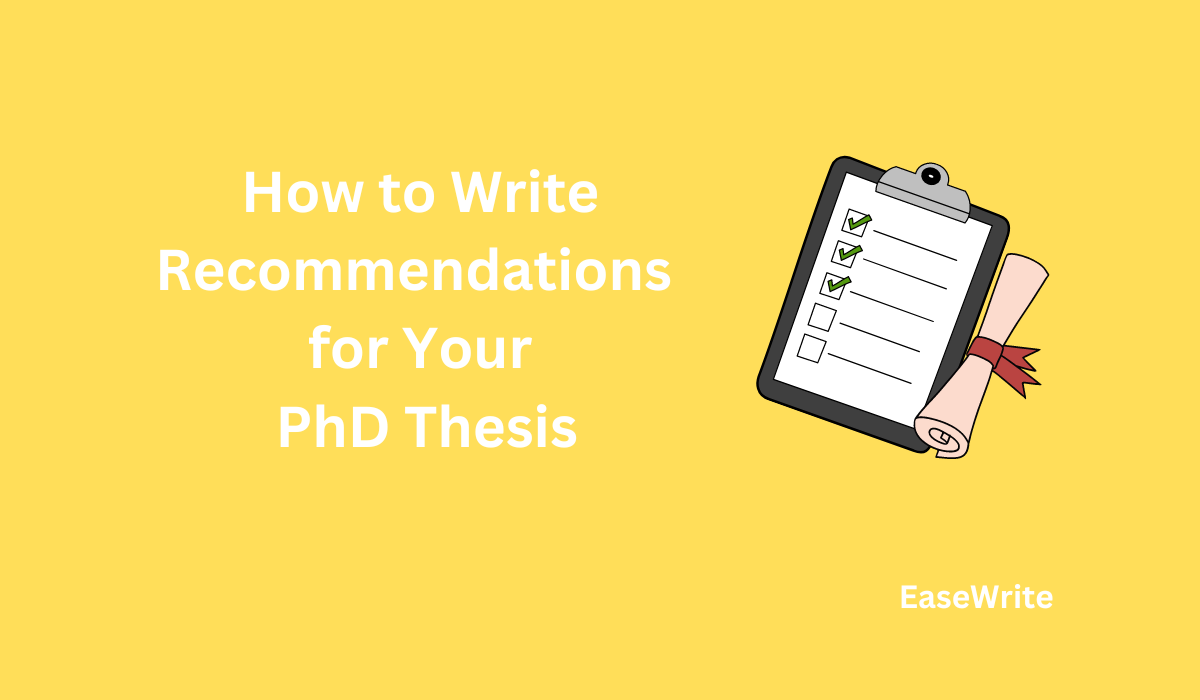Table of Contents
Introduction
Understanding the Importance of Recommendations
Steps to Writing Effective Recommendations
- Review Your Findings
- Identify Key Issues
- Suggest Practical Solutions
- Prioritize Recommendations
- Provide Justifications
Structuring Your Recommendations Chapter
- Introduce your Purpose and Findings
- Detailed Recommendations
- Key Issue Identification
- Recommendation
- Justification
- Prioritization of Recommendations
- Integration with Findings
- Concluding the section
- Future Research
Suggestions for Further Research
Rationale for Future Research Directions
Examples of Recommendation Writing
Common Mistakes to Avoid
Conclusion
Bonus Section!!
Prompts for Generative AI or Chat GPT to write recommendations for your Thesis
Introduction
Congratulations on reaching the final stages of your thesis project! One of the most crucial sections of your thesis is the recommendations chapter. This is where you provide actionable suggestions based on your research findings. In this article, we will walk you through how to write effective recommendations, complete with examples to inspire you. Let’s dive in and make your recommendations impactful and memorable.
Understanding the Importance of Recommendations
Purpose: The recommendations section is essential as it translates your research findings into practical solutions that can be implemented. This section highlights the significance of your research and shows how it can be applied in real-world scenarios.
Steps to Writing Effective Recommendations
- Review Your Findings
Before you start writing your recommendations, thoroughly review your research findings. Identify the key issues and insights that emerged from your study.
- Identify Key Issues
Pinpoint the main problems or challenges revealed by your research. This step ensures that your recommendations address the most critical aspects of your study.
- Suggest Practical Solutions
For each key issue, propose practical and feasible solutions. Your recommendations should be specific, actionable, and realistic.
- Prioritize Recommendations
Rank your recommendations based on their importance and impact. This helps readers understand which actions are most urgent and which ones can be implemented later.
- Provide Justifications
For each recommendation, provide a clear justification. Explain why this solution is appropriate and how it addresses the identified issue.
Structuring Your Recommendations Chapter
1. Introduce your Purpose and Findings
Purpose: Briefly introduce the recommendations chapter, explaining its purpose and importance.
Context: Provide a brief overview of the research problem and key findings to set the context for the recommendations.
2. Detailed Recommendations
For each recommendation, follow a consistent structure to ensure clarity and coherence:
a. Key Issue Identification
Description: Clearly describe the issue or challenge identified from your research findings.
Evidence: Summarize the relevant findings that highlight this issue.
b. Recommendation
Actionable Suggestion: Provide a specific, practical, and feasible solution to address the identified issue.
Steps for Implementation: Outline the steps required to implement the recommendation, if necessary.
c. Justification
Rationale: Explain why this recommendation is important and how it addresses the issue.
Expected Impact: Discuss the potential benefits and positive outcomes of implementing the recommendation.
Example Structure for a Single Recommendation:
Key Issue: Describe the issue identified.
Recommendation: Provide a practical solution.
Justification: Explain the rationale and expected impact.
Repeat this structure for each recommendation you make.
3. Prioritization of Recommendations
Ranking: Prioritize the recommendations based on their importance and potential impact.
Explanation: Briefly explain the criteria used for prioritization (e.g., feasibility, urgency, resource availability).
4. Integration with Findings
Link to Findings: Ensure that each recommendation is clearly linked to the findings presented in your research. This will help in framing implications and suggestions for your thesis.
Consistency: Maintain consistency between your findings and recommendations to reinforce the credibility of your research.
5. Conclusion
Summary: Summarize the key recommendations and their anticipated impact.
Call to Action: Encourage stakeholders to consider and implement the recommendations.
6. Future Research
Suggestions: Offer suggestions for future research that could build on your findings and recommendations.
Rationale: Explain how further research could help address remaining questions or challenges.
Examples of Recommendation Writing
Example 1:
Key Issue: Low employee engagement in the company.
Recommendation: Implement a comprehensive employee engagement program that includes regular feedback sessions, team-building activities, and professional development opportunities.
Justification: Engaged employees are more productive, motivated, and loyal. This program will help improve morale and reduce turnover rates.
Example 2:
Key Issue: Inefficient customer service processes.
Recommendation: Adopt a customer relationship management (CRM) system to streamline and automate customer service tasks.
Justification: A CRM system will enhance customer service efficiency by providing a centralized platform for managing customer interactions, leading to faster response times and higher customer satisfaction.
Common Mistakes to Avoid
Being Vague: Ensure your recommendations are specific and actionable.
Lack of Justification: Always explain why your recommendations are important.
Ignoring Feasibility: Make sure your recommendations are practical and realistic.
Overlooking Prioritization: Rank your recommendations to highlight the most critical actions.
Forgetting to Link to Findings: Your recommendations should directly stem from your research findings.
Conclusion
Writing recommendations for your thesis project can significantly enhance its value and impact. By following the steps outlined in this guide, you can create recommendations that are clear, practical, and compelling. Remember, your recommendations are a vital part of demonstrating the relevance and applicability of your research. Stay motivated, and best of luck with your writing journey!
Bonus Section!!
Prompts for Generative AI or Chat GPT to write recommendations for your Thesis
Prompt 1:
“I have completed the findings section of my thesis on the impact of social media marketing on consumer behavior. Could you help me generate specific and actionable recommendations based on my findings? Highlight key issues identified and provide practical solutions, along with justifications for each recommendation.”
Prompt 2:
“I’m writing the recommendations chapter for my thesis on sustainable urban planning. I need assistance in formulating recommendations that address the main issues identified in my research, such as inadequate green spaces and inefficient public transportation. Please provide detailed recommendations, prioritize them, and include justifications for each.”
These prompts are designed to guide the AI in generating focused and relevant recommendations that align with the key findings of your thesis project.
